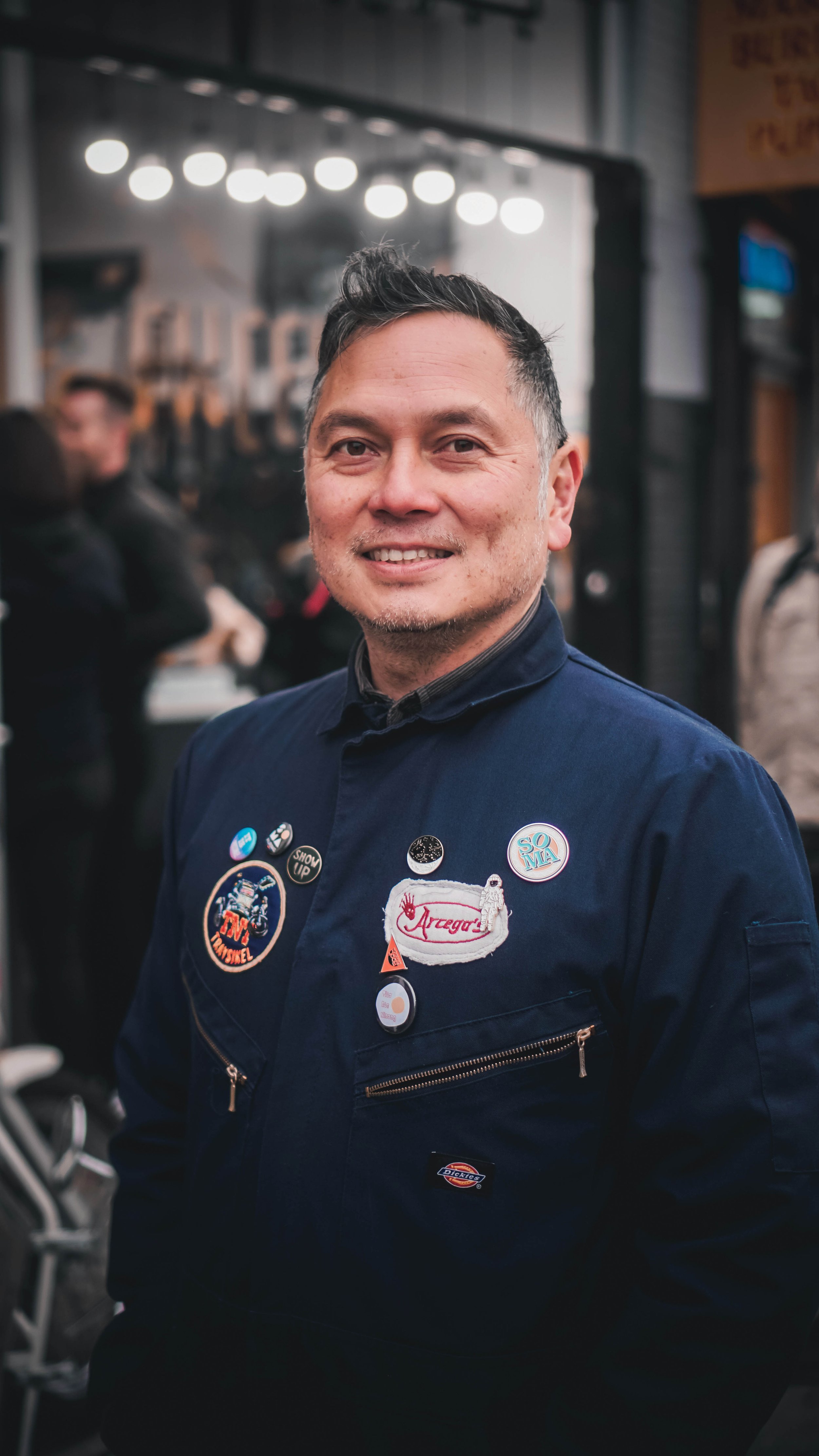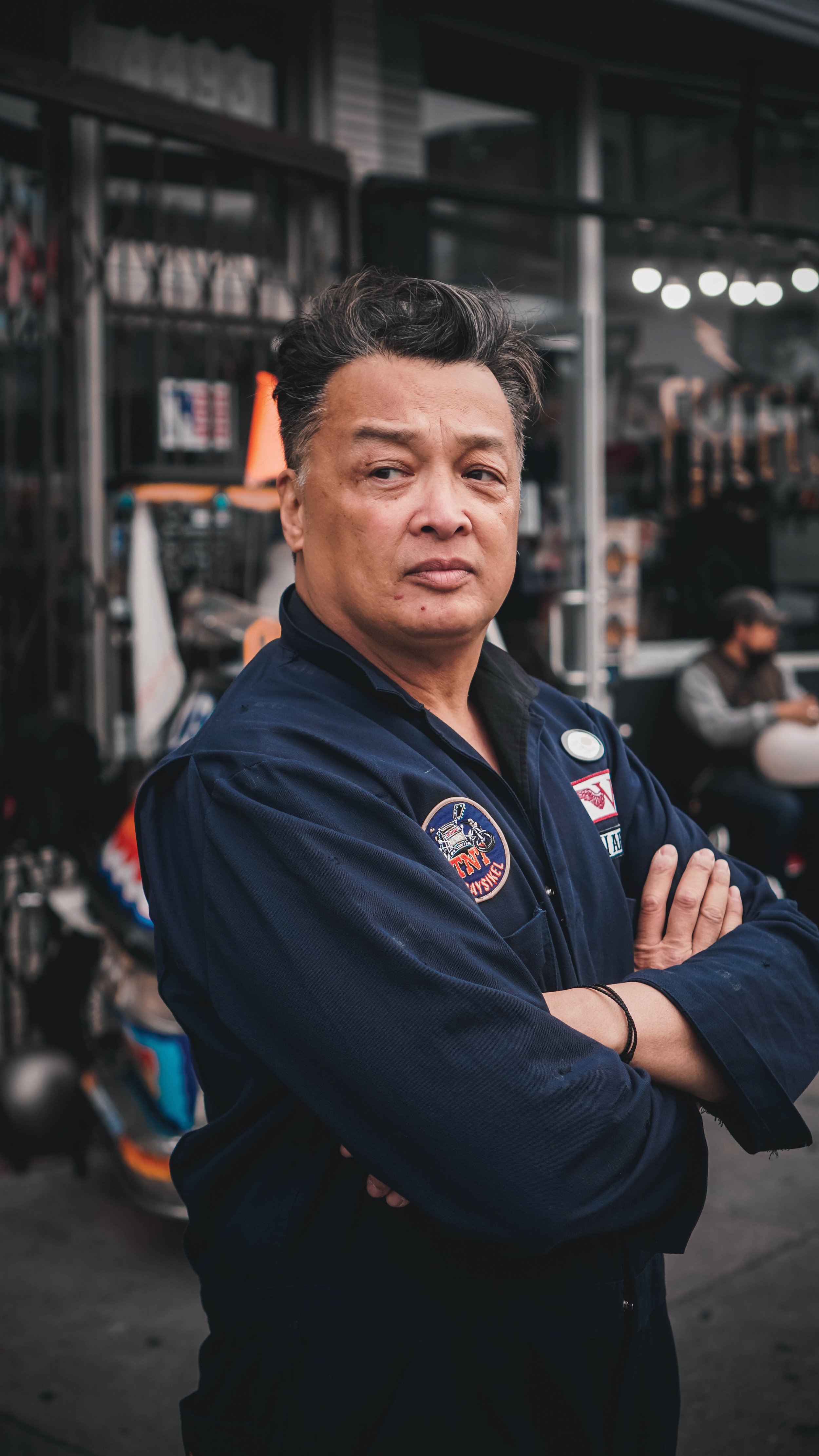Positively Filipinos Allowed: How TNT Traysikel is mobilizing community voices through storytelling
(Left to right) Paolo Asuncion, Michael Arcega, and Rachel Lastimosa pose in front of TNT Traysikel during The Moto Social event at Excelsior Coffee in San Francisco, Calif., on May 16, 2023. Photo: Alvin Dizon
TNT Traysikel is animated by an ethos of storytelling. Filipinx creatives Rachel Lastimosa, Paolo Asuncion, and Michael Arcega collaborated on the mobile art piece after San Francisco’s South of Market (SoMa) was designated a Filipino Cultural Heritage District in 2016.
In 2018, Arcega conceived of and secured funding for the object from the San Francisco Arts Commission (SFAC) after Lastimosa convened the district’s Arts and Culture Committee to support visibility efforts within the Filipinx artist community.
“How do we envision a Filipino cultural district?” Lastimosa said. “One thing that folks really wanted was to be able to see things that looked very familiar to them.”
Lastimosa, a music producer and community organizer who served as the Arts and Culture Administrator for SOMA Pilipinas, stressed the importance of soliciting SoMa residents’ voices in planning the neighborhood’s development and addressing their community’s historical erasure from the city’s cultural memory.
Asuncion and Arcega acquired an unadorned Honda motorcycle with a sidecar attachment from a pastor in Modesto, who brought the vehicle from the Philippines and used it to transport his congregation to church services. Traysikels are ubiquitous transportation in the Philippines, with their colorfully embellished exteriors refashioned from leftover World War II military vehicles. Its presence in the United States elicited the nostalgic connections Lastimosa, Asuncion, and Arcega hoped to manifest in SoMa.
“The intent of this project is to signal things that are larger and to act as a metaphor for a cultural personified experience,” Arcega said. “When people run across it, it’s just a motorcycle with a sidecar that’s heavily adorned. But to those that know, it’s more meaningful than that.”
Arcega, an interdisciplinary artist whose work highlights power dynamics in migration, explained that the piece was meant to resonate with the multifaceted lived experiences of Filipinx in the United States.
“Nobody really offers up their own personal immigrant stories of how they got here for fear of being judged for the way they got here and their origins in the Philippines,” Asuncion said.
Asuncion, an art director and independent filmmaker, emphasized how Filipinx feel compelled to share their narratives while sitting inside TNT Traysikel’s sidecar, troubling the silences often accompanying Filipinx migration.
“The Traysikel is the connecting point for creating those stories,” Lastimosa said.
To facilitate that storytelling, the crew collaborated with sign maker Michelle “Meng’’ Nguyen to adorn the vehicle with homages to the street cultures of the Philippines that fashioned traysikels in the context of U.S. militarization. Aesthetic references to jeepneys, ice cream carts, kalesas, and the yero used as corrugated tin roofing connect to the long histories of American empire in the Philippines.
“This is an object that is inherently American, through and through,” Arcega said. “It was made in the Philippines, but is derived from American occupation, an American education system, and consumerism. This object is evidence of American expansion.”
These colonial residues make TNT Traysikel a politically charged space. The politics of visibility and the legacies of U.S. imperialism rendering Filipinx as mobile, resilient, and disposable objects and bodies are on full display in the vehicle’s nomenclature.
Photo: Alvin Dizon
T-N-T is an acronym for “Tago Ng Tago” (always hiding), a Tagalog expression often used in hushed terms referencing undocumented Filipinx. The Migration Policy Institute and the U.S. Citizenship and Immigration Services reported approximately 313,000 undocumented Filipinx in the United States between 2012 and 2016.
Living while undocumented generates anxiety and uncertainty for Filipinx families, often requiring them to weave between structures of surveillance and policing maintained by U.S. immigration systems rooted in the transnational criminalization of Black and brown people. TNT Traysikel spotlights these systems as part of a larger activist praxis.
TNT Traysikel was crafted during the COVID-19 pandemic in 2020, when the Trump administration’s anti-Asian and anti-immigrant rhetoric intensified. Asuncion explained how the team planned to ride it around SoMa, vehemently proclaiming the existence of Filipinx in the city.
“Instead of being the model minority and keeping our heads down and just being quiet,” Asuncion said. “Let’s paint T-N-T on there and just own it and announce it.”
“Tago Ng Tago” does not solely refer to undocumented Filipinx. It also signals the socially constructed and nationalist project of making invisible the lines of empire along which Filipinx travel. Despite its Filipinx cultural exterior, a traysikel is a quintessentially American object. TNT Traysikel lays these histories bare.
“It’s jarring to a lot of people mainly because many Americans who have never been out of the country don’t understand what their country is doing outside of their own landscape,” Arcega said. “This is what America looks like to most people.”
TNT Traysikel is a vessel channeling diasporic joy, grief, and migrant memories. It is staking claims to power rooted in an understanding of mobility as an assertion of Filipinx agency in their ability to move despite state surveillance, restrictive immigration policies, and transpacific racial capitalism. It is also realized in TNT Traysikel’s deliberate activism.
“The protest rides were the other kind of social component that this thing has had,” Arcega said. “We were able to join the Black Lives Matter solidarity rides and the anti-Asian hate rides. Using this object as a way to represent and be in solidarity with other folks’ struggles is really important to the ethos of the work.”
Photo: Alvin Dizon
These guiding principles also manifest in one of TNT Traysikel’s primary activations: karaoke.
Following its inception as a popular cultural practice in the 1960s, the pastime gained global cultural sway by the 1980s and became a ubiquitous practice at Filipino gatherings, which accompanied migrations to the United States. Singing karaoke in TNT Traysikel allows Filipinx in the diaspora to process the grief of their displacement through the joy of engaging with a nostalgic object facilitating a familiar social practice. Lastimosa described this as a sacred interaction.
“I call it a portal,” Lastimosa said. “It’s almost like its own sentient being. It’s a metaphor for the immigration experience.”
TNT Traysikel has become a steadfast platform for amplifying Filipinx voices through their “sidecaraoke” activations at different events throughout San Francisco. Some of their most notable appearances have been at Kapwa Gardens, the Asian Art Museum, San Francisco Museum of Modern Art, Yerba Buena Center for the Arts, and the St. Joseph’s Arts Society’s gatherings conducted out of St. Joseph’s Church in SoMa, which was the site of the largest Filipino American congregation in the United States until 1989.
“Providing that space, creating the container and the platform to sing at the top of your lungs, to scream if needed,” Lastimosa said. “This signifies that we don’t have to be quiet and submissive; that we can be that dramatic Filipino.”
(Left to right) Alvin Dizon, Michael Arcega, Rachel Lastimosa, and Paolo Asuncion pose in front of TNT Traysikel during The Moto Social event at Excelsior Coffee in San Francisco, Calif., on May 16, 2023. Photo: Alvin Dizon
Lastimosa, Asuncion, and Arcega continue to extend the object’s activations. In 2021, Asuncion applied his directorial perspectives to the crew’s upcoming film project backed by the SFAC, “Lost & Found: TNT in America.” An abridged version of the film was shown at Art Market San Francisco on April 23, followed by a panel discussion led by artist and curator Trisha Lagaso Goldberg.
“We want to expand karaoke to include other things like performance art,” Arcega said. “Or make it more inclusive since we are able to create a platform for voice and expression.”
TNT Traysikel is meeting the needs of a community reckoning with the multivalent violence of Filipinx erasure by collecting and sharing their narratives. Their work demonstrates that Filipinx have been inextricably vital to transpacific U.S. politics, society, and culture for over a century.
“It’s not just about this object that’s goofy and joyful and is super hype and has lights and karaoke,” Asuncion said. “It’s a lot more than that. It’s all about the stories that come with it.”
Storytelling is at the heart of TNT Traysikel. Lastimosa, Arcega, and Asuncion brought that intention to Mahalaya newspaper’s first-anniversary celebration on June 3, when the trio set up the sidecar to record attendees’ accounts of their migrant experiences. This debut activation centered conversations around belonging and finding community. TNT Traysikel will continue collecting these stories to further its creators’ mission of affirming the power and validity of Filipinx presence in the United States.
“We belong here just as much as any person,” Arcega said. “Whether you were born in the Philippines and emigrated or you were born in the United States but still feel alienated. You belong here.”







